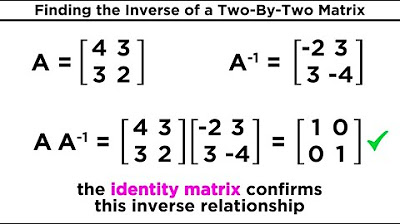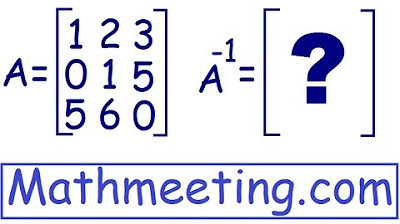PreCalculus - Matrices & Matrix Applications (21 of 33) Using the Determinant to Find the Inverse
TLDRThis video tutorial introduces a quick method for finding the inverse of a 2x2 matrix, focusing on the use of determinants and matrix element manipulation. It explains that the inverse is calculated by swapping the positions of elements A and D and changing the signs of elements B and C, all divided by the determinant (AD - BC). A clear example is provided, demonstrating how to calculate the determinant, form the inverse matrix, and verify it by multiplying it with the original matrix to obtain the identity matrix. The video also teases a more general method for matrices of higher dimensions in a forthcoming tutorial.
Takeaways
- 📌 The video introduces two methods for finding the inverse of a matrix, with a focus on the specific technique for 2x2 matrices.
- 🔍 The method discussed is applicable only to 2x2 matrices and is a quick way to find the inverse.
- 👉 The inverse of a matrix A with elements a, b, c, and d is found by swapping a and d and changing the signs of b and c.
- 🧮 The determinant (denoted as D) of a 2x2 matrix is calculated as (ad - bc) and is crucial for finding the inverse.
- ⚙️ The formula for the inverse of a 2x2 matrix is given by 1/D * [a -b; -c d], where D is the determinant.
- 🌟 The video provides a step-by-step example of finding the inverse of a matrix with elements 2, 1, 5, and 3.
- 🔢 The determinant in the example is calculated as (2*3 - 1*5) which equals 1.
- 🔄 To verify the inverse, the video demonstrates multiplying the original matrix by its inverse, which should yield the identity matrix.
- 📈 The result of the multiplication confirms the correctness of the inverse, showing the identity matrix as proof.
- 🎥 The video concludes by mentioning that a more general method for finding the inverse of matrices of any dimension will be covered in the next video.
- 📚 The video serves as a tutorial for those looking to understand and apply the process of matrix inversion, particularly for 2x2 matrices.
Q & A
What is the main topic of the video?
-The main topic of the video is how to find the inverse of a 2x2 matrix.
How many methods are mentioned for finding the inverse of a matrix?
-Two basic methods are mentioned in the video, one specific for 2x2 matrices and another more general method for matrices of any dimension.
What is the determinant in the context of a 2x2 matrix?
-The determinant is the product of the diagonal elements of the matrix minus the product of the off-diagonal elements.
How is the inverse of a 2x2 matrix calculated?
-The inverse of a 2x2 matrix is calculated by taking the reciprocal of the determinant and then swapping the positions of elements A and D, and changing the signs of elements B and C.
What happens to elements B and C when finding the inverse of a matrix?
-When finding the inverse of a matrix, elements B and C change to the opposite sign; if B is positive, it becomes negative, and the same applies to C.
How do you verify the correctness of the calculated inverse?
-To verify the correctness of the calculated inverse, you multiply the original matrix by its inverse, which should result in the identity matrix.
What is the identity matrix?
-The identity matrix is a square matrix with ones on the diagonal and zeros elsewhere, such that when multiplied by another matrix, the original matrix is returned.
What are the elements of the example matrix provided in the video?
-The elements of the example matrix provided in the video are 2, 1, 5, and 3.
What is the determinant of the example matrix?
-The determinant of the example matrix is 1, calculated as (2 * 3) - (1 * 5).
What is the inverse of the example matrix?
-The inverse of the example matrix is the matrix [3, -1, -5, 2].
What will be covered in the next video?
-In the next video, a more general method for finding the inverse of a matrix will be shown, starting with a 2x2 matrix and then extending the technique to a 3x3 matrix.
Outlines
📚 Introduction to Finding the Inverse of a 2x2 Matrix
This paragraph introduces the topic of finding the inverse of a 2x2 matrix. It explains that there are two basic methods to do this, with the one presented being specific to 2x2 matrices. The other method, to be discussed in a subsequent video, is more general and applicable to matrices of any dimension, albeit more complex for larger matrices. The paragraph emphasizes the practicality and speed of the method being introduced, which relies on the concept of the matrix determinant and the transposition of matrix elements.
Mindmap
Keywords
💡2x2 matrix
💡Inverse of a matrix
💡Determinant
💡Identity matrix
💡Diagonal elements
💡Off-diagonal elements
💡Matrix multiplication
💡Linear algebra
💡General method
💡Elementary operations
Highlights
Introduction to finding the inverse of a 2x2 matrix
Two basic methods for finding the inverse of a matrix, with one specific to 2x2 matrices
The determinant is crucial for calculating the inverse of a 2x2 matrix
Interchanging elements A and D, and inverting the signs of elements B and C to find the inverse
The determinant is calculated as (A*D) - (B*C)
The inverse of a matrix is found by multiplying 1 over the determinant with the matrix elements
Example given: finding the inverse of a 2x2 matrix with elements 2, 1, 5, and 3
Calculating the determinant for the example matrix results in 1
The inverse of the example matrix is found by rearranging and inverting the signs of its elements
Verification of the inverse matrix by multiplying it with the original matrix to obtain the identity matrix
Demonstration of the matrix multiplication to confirm the inverse
Result of the multiplication showing the identity matrix, confirming the inverse is correct
预告下一个视频将展示更通用的矩阵求逆方法
即将展示如何将2x2矩阵求逆的通用方法扩展到3x3矩阵
This method is efficient for 2x2 matrices and can be done quickly
Transcripts
5.0 / 5 (0 votes)
Thanks for rating:





